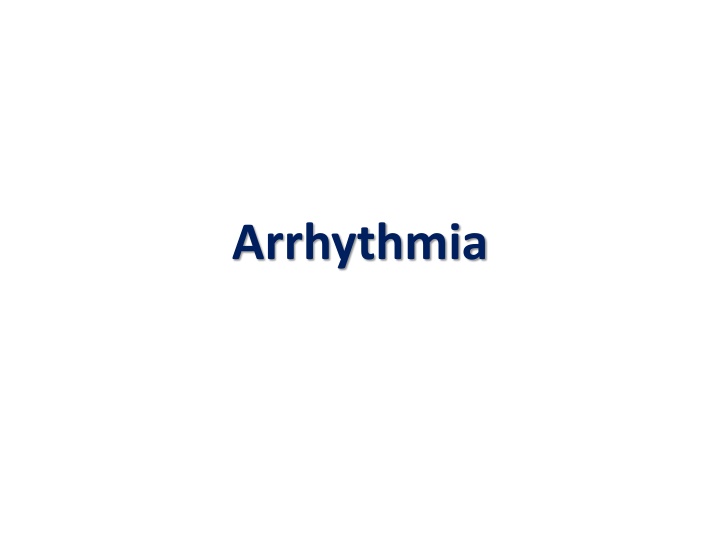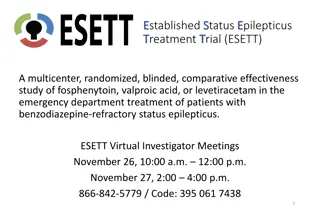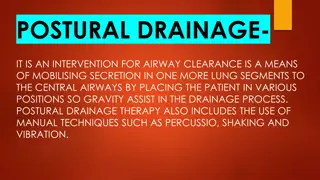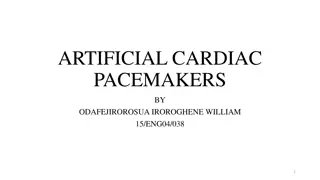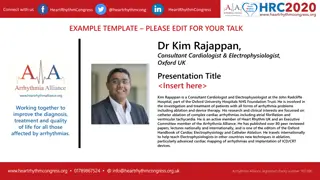Arrhythmia
Arrhythmia is defined as a loss of cardiac rhythm, leading to irregular heartbeats. Common types include atrial fibrillation and flutter, which result in irregular pulse patterns and pose serious health risks. Reentry mechanisms, often associated with organic heart diseases, play a crucial role in the development of arrhythmias. Recognizing the symptoms and understanding the underlying pathophysiology is essential for appropriate treatment and management.
Download Presentation

Please find below an Image/Link to download the presentation.
The content on the website is provided AS IS for your information and personal use only. It may not be sold, licensed, or shared on other websites without obtaining consent from the author.If you encounter any issues during the download, it is possible that the publisher has removed the file from their server.
You are allowed to download the files provided on this website for personal or commercial use, subject to the condition that they are used lawfully. All files are the property of their respective owners.
The content on the website is provided AS IS for your information and personal use only. It may not be sold, licensed, or shared on other websites without obtaining consent from the author.
E N D
Presentation Transcript
Arrhythmia is defined as loss of cardiac rhythm, especially irregularity of heart beat. PATHOPHYSIOLOGY: SUPRAVENTRICULAR ARRHYTHMIAS: Common supraventricular requiring drug treatment are atrial fibrillation (AF) or atrial supraventricular tachycardia automatic atrial tachycardias. tachycardias flutter, paroxysmal (PSVT), and
Atrial Fibrillation and Atrial Flutter: AF is characterized as an extremely rapid (400 to 600 atrial beats/min) and disorganized atrial activation. There is a loss of atrial contraction (atrial kick), and supraventricular impulses penetrate the atrioventricular (AV) conduction system in variable degrees, resulting ventricular activation and irregularly irregular pulse (120 to 180 beats/min). in irregular
Atrial flutter is characterized by rapid (270 to 330 atrial beats/min) activation. but regular atrial The ventricular response usually has a regular pattern and a pulse of 300 beats/min. This arrhythmia occurs less frequently than AF but has similar consequences, and drug therapy. precipitating factors,
The predominant mechanism of AF and atrial flutter is reentry, which is usually associated with organic heart disease that causes atrial distention (e.g., ischemia hypertensive heart disorders). or infarction, valvular disease, PSVT includes arrhythmias caused by AV nodal reentry, AV reentry anomalous AV pathway, sinoatrial (SA) nodal reentry, and intra atrial reentry. arising by reentrant mechanisms incorporating an
Automatic multifocal atrial tachycardia appear to arise from supraventricular foci with enhanced automatic properties. atrial tachycardias such as Severe pulmonary disease is the underlying precipitating disorder in 60% to 80% of patients.
VENTRICULAR ARRHYTHMIAS: Premature Ventricular Complexes: Premature ventricular complexes (PVCs) are common ventricular rhythm disturbances that occur in patients with or without heart disease and may be elicited experimentally by abnormal automaticity, triggered activity, or reentrant mechanisms.
Ventricular Tachycardia: Ventricular tachycardia (VT) is defined by three or more repetitive PVCs occurring at a rate greater than 100 beats/min. It occurs most commonly in acute myocardial infarction (MI); other electrolyte abnormalities (e.g., hypokalemia), hypoxemia, and digitalis toxicity. causes are severe The chronic recurrent form is almost always associated with underlying organic heart disease (e.g., idiopathic dilated remote MI with left ventricular [LV] aneurysm). cardiomyopathy or
Torsades de pointes QRS complexes varying in amplitude, axis and duration.
Incessant VT refers to VT occurring more frequently than sinus rhythm, so that VT becomes the dominant rhythm. Monomorphic VT has a consistent QRS configuration, whereas polymorphic VT has varying QRS complexes. Torsade de pointes (TdP) is a polymorphic VT in which the QRS complexes appear to undulate around a central axis.
BRADYARRHYTHMIAS: Asymptomatic sinus bradyarrhythmias (heart rate less than 60 beats/min) are common especially in young, athletically active individuals. However, some patients have sinus node dysfunction (sick sinus syndrome) because of underlying organic heart disease and the normal aging process, which attenuates SA nodal function. AV block or conduction delay may occur in any area of the AV conduction system. AV block may be found in patients without underlying heart disease (e.g., trained athletes) or during sleep when vagal tone is high.
CLINICAL PRESENTATION Supraventricular tachycardias may cause a variety of clinical manifestation ranging from no symptoms to minor palpitations and/or irregular pulse to severe and even life-threatening symptoms. Patients may experience dizziness or acute syncopal episodes; symptoms of HF; anginal chest pain; or, more often, a choking or pressure sensation during the tachycardia episode. Patients with bradyarrhythmias experience symptoms associated with hypotension syncope, fatigue, and confusion. such as dizziness, If LV dysfunction exists, symptoms of congestive HF may be exacerbated.
DESIRED OUTCOME The desired underlying arrhythmia. outcome depends on the For example, the ultimate treatment goals of treating AF or atrial flutter are restoring sinus rhythm, preventing complications, and recurrences. thromboembolic preventing further
Drugs may have antiarrhythmic activity by directly altering conduction in several ways. Drugs may depress the automatic properties of abnormal pacemaker cells by decreasing the slope of phase 4 depolarization and/or by elevating threshold potential.
Acute Ventricular Tachycardia If severe symptoms are present, synchronized DCC should be institute immediately to restore sinus rhythm. Patients with mild or no symptoms can be treated initially with antiarrhythmic drugs. IV amiodarone is now recommended as situation. first-line therapy in this Patients with chronic recurrent sustained VT are at extremely high risk for death; trial-and-error attempts to find effective therapy are unwarranted. The defibrillator) is a highly effective method for preventing sudden death due to recurrent VT or VF. automatic ICD (implantable cardioverter-
For an acute episode of TdP, most patients require and respond to DCC. However, TdP tends to be paroxysmal and often recurs rapidly after DCC. IV magnesium sulfate is considered the drug of choice for preventing recurrences of TdP. Agents that prolong the QT interval should be discontinued, and exacerbating hypokalemia, hypomagnesemia) corrected. Drugs that further prolong repolarization (e.g., IV procainamide) are contraindicated. Lidocaine is usually ineffective. factors (e.g.,
Treatment elimination of symptomatic bradycardia and possibly managing alternating tachycardias such as AF. of sinus node dysfunction involves In general, long-term therapy of choice for patients with significant symptoms is a permanent ventricular pacemaker. Patients who remain symptomatic may benefit from adding an -adrenergic stimulant such as midodrine. Other drugs that have been used successfully (with or without -blockers) anticholinergics (scopolamine patches, disopyramide), -adrenergic agonists (midodrine), adenosine analogs (theophylline, dipyridamole), and selective serotonin reuptake inhibitors (sertraline, fluoxetine). include fludrocortisone,
Adenosine: Drug therapy involves blocking the AV node because most PSVT rhythms involve a re-entry circuit within this area. An initial 6-mg IV bolus is given; if this is unsuccessful within 2 minutes, it can be followed by one or two additional 12-mg IV boluses, up to a maximum of 30 mg. Because of its short half-life (9 seconds), adenosine should be administered as a rapid bolus (over 1 3 seconds), followed immediately by a saline flush. Nondihydropyridine calcium channel blockers, verapamil and diltiazem, can be used in patients with PSVT. Verapamil (2.5 5 mg IV given over 2 minutes) achieves peak therapeutic effects in 3 to 5 minutes after dosing and can be repeated at 10- to 15-minute intervals to a maximum dose of 20 mg if needed.
In high-risk patients with MI who are not candidates for -blockade, antiarrhythmic therapy with amiodarone can be considered. alternative Amiodarone is a class III antiarrhythmic agent but also has antiadrenergic, class I, and class IV activity. Treatment with amiodarone (800 mg/day for 7 days followed by 400 mg/day for 6 days of the week for 1 year) was associated with a significant reduction in cardiac mortality and significant ventricular arrhythmias.
